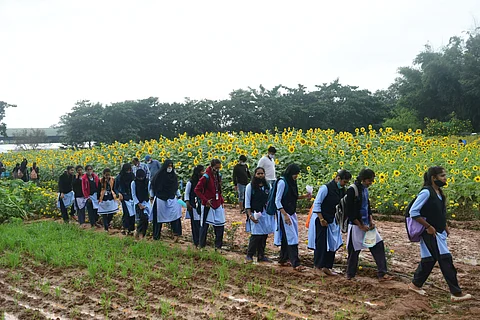

About half of the tribal students who pass Class X do not enroll for higher secondary classes in Tamil Nadu, according to a statistical report released by the Ministry of Tribal Affairs. The report further shows that the tribal women literacy rate is 20 per cent less than other women in Tamil Nadu.
In a statement responding to a query raised by Villupuram MP Ravikumar in the Parliament on Monday, that is December 13, the ministry released state-wise literacy rate of Scheduled Tribes (ST) and ST women in 2011 census, the schemes implemented for their education and the Gross Enrollment Ratio (GER) of ST students for the year 2019-20. The female literacy rate of STs in the state is 46.8 per cent as against 49.4 per cent nationally, as per the statement. The difference is less than three per cent against the national scale but female literacy of the overall population in TN is at 73.14. This shows that an average woman in Tamil Nadu has 26.3 per cent higher chances of being literate than a tribal counterpart.
"The government must enact the central government schemes for tribal students in addition to creating awareness on school education among the communities. The social welfare, school education and the ST welfare board must come together to improve female and overall literacy rate for the tribal communities," said retired IAS officer and former additional chief secretary R Christodas Gandhi.
However, the data corresponding to the 2011 census may have variations with the present status so, the assessment of Gross Enrollment Ratio (GER) of ST and other students for the year 2019 to 2020 indicate the real picture. The drop in enrollment per cent is evident of the lack of higher education opportunities for ST students. The GER index (2019-20) of ST students in Tamil Nadu enrolled for Classes IX to X stands at 105.4 against a national average of 76.7. However, the students enrolled in Classes XI and XII goes down to 65.7 per cent, a drop by about 40 per cent, evidently stating there are challenges for tribal students to access higher secondary school education. This means 40 per cent of ST students who pass Class X in Tamil Nadu do not pursue school education any further.
Activists state that the socio-economic conditions of ST students contribute to this factor including early marriage for young girls among the communities, lack of community certificate and the nomadic culture of the indigenous population. Moreover, the school education department must pay better attention to tribal schools while government schools with tribal children must have at least one teacher who can speak the native language of the communities, suggested Tamil Nadu Tribal People Association state committee member VP Gunasekaran.
According to Gunasekaran, "A teacher or a resource person must be employed at government schools where tribal children are enrolled in order to relate to their livelihoods and to provide a psychologically secure environment for the students. Now, most of the teachers who teach at tribal schools at hill stations come from the foothills who have little or no idea of the life led in the hills by the students. This gap in understanding the lives of ST students between the faculty and the student needs to be bridged to prevent higher secondary school drop out rate among the communities. Due to the semi-nomadic nature of most tribes in Tamil Nadu, students are forced to miss out on higher education opportunities as they are constantly migrating from one town to another."
Irular tribal rights defender and activist Piraba Kalvimani, who has done extensive ground work with nomadic tribes in the state, informed that, "The constant migration also contributes to the delay or cancellation in issuing of community certificates for many students between Classes VII to IX putting their higher secondary school to doubt. Another underlying reason that often goes unnoticed is the students' fear of being humiliated at school by teachers for the lack of community certificate. The third main reason will be lack of awareness among communities to pursue school and college, which must be intervened by the school education department."
What is GER?
Gross Enrolment Ratio (GER): Total enrollment in a specific level of education, regardless of age, expressed as a percentage of the eligible official school-age population corresponding to the same level of education in a given school-year. It is calculated by dividing the number of students enrolled in a given level of education by the population of the age-group and multiplying the result by 100.
